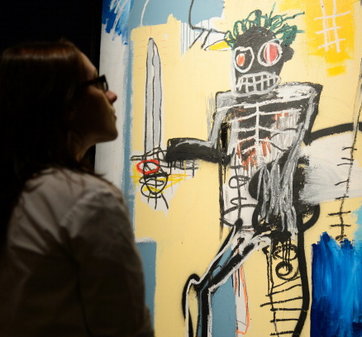Barbarians at the Art Auction Gates? Not to Worry

Jean-Michel Basquiat’s “Warrior” had a rapid turnover at auctions. Credit Leon Neal/Agence France-Presse — Getty Images
In one striking example, Jean-Michel Basquiat’s “Warrior” sold three times at auction between 2005 and 2012, the painting’s price soaring during those seven years by 450 percent, to nearly $9 million.
In another, at Christie’s this May, an Alex Israel sky painting drew over $1 million, more than 10 times what paintings from this series fetched when they were created less than two years ago.
Such soaring prices and quick resales, especially of work by emerging artists, have fueled a perception that a new breed of collectors, fond of flipping art as they would a stock, have overtaken the market. In this view, widely held in the art world, work once valued for its lofty, aesthetic appeal has become a mere commodity, just another asset class for hedge-fund millionaires and others to cash in.
But separate statistical analyses conducted for The New York Times by two companies that specialize in evaluating art market data indicate that the hand wringing may be premature.
Yes, for the past few years, postwar and contemporary art has been reselling at auction faster than, say, a decade ago, the data show. But the pace last year was only slightly faster than it was in the mid-1990s, signaling that the reselling may be just the latest iteration of a historical cycle, not a lasting change.
After a few years, during which the pace of reselling accelerated, the data show that owners of postwar and contemporary works are holding onto their artwork longer again. “After all I had read about flipping, when looking at the market itself, it’s really business as usual,” said Fabian Bocart, a founder of Tutela Capital S.A., a consultancy in Brussels that prepared one of the analyses for The Times.
“Reselling art at auction is not a new phenomenon,” he wrote in the report, “or at least, not very different from what has existed since 1995.”
At the request of The Times, Tutela Capital and Beautiful Asset Advisors, a New York company best known for its Mei Moses family of indexes, reviewed art market data from 1995 through 2013 to see if there had been a noticeable shortening in the time owners held onto art. The discussion of the issue has largely focused on the postwar and contemporary markets, where there is the perception that a commodities trading approach has become prevalent. This view has been fueled by a drumbeat of headlines about flipping; the emergence of companies like ArtRank, which give “buy” and “sell” ratings for works; and the high profile of collectors who buy pieces by new artists in bulk and sell them for a handsome profit.
“Many buyers today seem eager to buy the ‘new kid on the block’ — the hot, young, talked-about artist — for a low price and, in a short time, put the work up for sale, anticipating to receive a multiple of what they paid,” said Angela Westwater of the Sperone Westwater gallery.
At Israel Lund’s New York solo debut in June 2013, for example, an untitled yellow-and-gray painting sold for $7,500; this May it sold for $125,000 at Christie’s. Similar examples abound for recently created works by artists like Lucien Smith and Oscar Murillo.
But the data indicate that contemporary works appearing at auction within three years of their creation are not coming to auction faster than in the past, and that such flipping remains very much the exception, not the rule. Though more works come up for sale each year, the percentage of these works was essentially the same last year, less than 2 percent, as in 2007, Tutela Capital found.
Beautiful Asset did another review of the art market, using a different measure, and reached a similar conclusion: While, historically, the percentage of works resold within five years is higher now than it was, say, two decades ago, that percentage has been decreasing since 2008.
“It reached a high right before and after the financial crisis,” said Michael Moses, a founder of Beautiful Asset, “and it has been declining since.”

Alex Israel’s “Sky Backdrop” soared in value within two years. Credit Christie'S Images Ltd.
Beautiful Asset tracks sales at Christie’s and Sotheby’s, which by themselves account for about three-quarters of the value of the auction market worldwide but a smaller amount of the volume. Tutela Capital collects data from more than 2,500 auction houses. Both use the provenances supplied at the time of auction to track prior sales of a work, including those, in the case of Beautiful Asset, that occur at houses where data are not routinely collected.
The analysts’ methodologies were reviewed by two experts, Stephen T. Ziliak, professor of economics at Roosevelt University, and Alan F. Karr, director of the National Institute of Statistical Sciences and a professor of statistics and biostatistics at the University of North Carolina, Chapel Hill. Both experts found the methods sound.
“Ultimately, I think the market is reassuringly stable,” said Thomas Galbraith, the managing director of auctions at Paddle8, an online auction house. He said the scourge of the speculative investor has long haunted the art market.
“If it’s not the hedge funds or venture capitalists, then in the ’80s it was the Japanese,” he said. “And if it wasn’t them, then, at the turn of the century, it was American industrialists. It’s a cycle, it’s repeating, and in a way it’s very reassuring. I don’t think it’s something that we necessarily need to be frightened of, because we’ve seen this story before.”
Some of the fuss over flipping is related to its reputation as a vulgar way to collect art. Old World moneyed families were often embarrassed to be seen selling things, veteran dealers said, and galleries have long frowned on flipping. Wanting to control the market for their artists, dealers prefer to sell to collectors who will hold onto their purchases, worried that, while frequent resales may boost prices initially, they can hurt an artist’s staying power and ultimately devalue artwork.
Artists said that frequent resales of their works can generate creativity-stifling pressure to produce more of the same to feed the market. And the pace can be unsettling, even if prices rise in the short term.
From 2006 to 2007, Peter Doig’s painting “White Canoe” sold twice, drawing about $10 million at auction the second time around, the most paid for one of his works at the time.
“I was very nervous” after the sale, Mr. Doig said in an interview from his home in Trinidad. “I felt that things would change for me, that people would talk about that rather than the work.”

Peter Doig’s “White Canoe” sold twice in two years, skyrocketing in price. Credit Peter Doig
“It made it more difficult to paint for me,” he added. “I became more cynical. I just wondered why I was doing it: ‘Am I doing it to make rich people richer?’ ”
“White Canoe” had initially been sold at auction in 2006 by the prominent art collector Charles Saatchi — one of seven Doig paintings he sold through Sotheby’s that year. Mr. Doig said he was among the artists who had stopped selling to Mr. Saatchi because of his reputation for pumping and then dumping artwork.
“Everybody knows that’s what he does,” Mr. Doig said.
But if Mr. Saatchi is a flipper, he certainly does not embrace the title. In an article he wrote for The Guardian in 2011, he excoriated newcomers who he said had changed the culture of collecting.
“Being an art buyer these days is comprehensively and indisputably vulgar,” he wrote. “It is the sport of the Eurotrashy, hedge-fundy, Hamptonites; of trendy oligarchs and oiligarchs; and of art dealers with masturbatory levels of self-regard.”
The data analyses, however, indicate that, although such collectors may be conspicuous, they are not yet commonplace.
Beautiful Asset found that contemporary and postwar artworks resold at Christie’s and Sotheby’s last year had been held by their owners an average of 11.2 years, the highest level in six years and a reflection of behavior similar to that exhibited in the late 1990s.
Major auction houses said they had not performed calculations to test the flipping thesis but said they believed the prevalence of that buying behavior had been overstated. “The speculative art buyer, or ‘flipper,’ motivated purely by short-term investment potential, is the anomaly in our experience,” Christie’s said in a statement.
One factor that slows collectors who might be interested in flipping art is the size of the fees they pay auction houses to purchase a work. Someone, for example, who has bid $1 million for a painting is typically charged another $205,000 in fees, known as the buyer’s premium. So the art has to be held long enough to appreciate and cover those costs, a situation not unlike that faced by homeowners when calculating whether it makes sense to refinance, given the closing costs.
Mr. Bocart of Tutela Capital said that people alarmed by changes in the art market might be reading too much into the idea that a new breed of collectors is transforming the culture.
“They see bankers and hedge-fund managers coming into the market, and they have a preconceived idea of what they will do,” he said. “But they’re not the rogues or vultures they imagine.”
By Lorne Manly and Robin Pogrebin